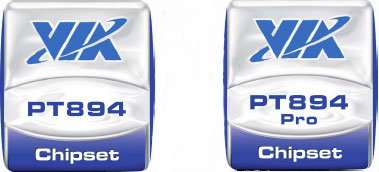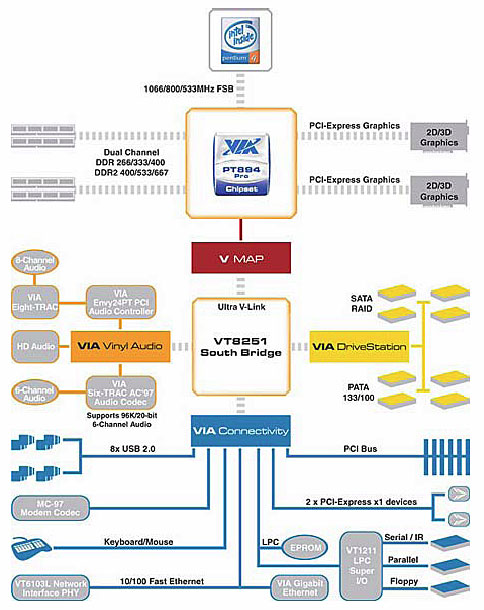VIA PT Series: VIA PCI Express for Intel
by Wesley Fink on January 31, 2005 12:01 PM EST- Posted in
- CPUs
PT894 & PT894 PRO
The 894 chipset family is aimed at the computer enthusiast.


The 894 and 894 Pro differ only in the graphics capability, with the Pro version able to run two PCI Express cards driving up to 4 monitors. This is not the same as the SLI solution provided by the nVidia chipset for the AMD Athlon 64. SLI combines the capabilities of 2 PCIe cards in alternate frame rendering, while the VIA Intel solution merely supports two PCIe video cards running at the same time - one, a full x16 and the other, x4. VIA calls this feature "Video GFX".
The emphasis in Video GFX is multi-monitor support, which can be useful in many different system configurations.
- PCI Express x16 Lane for primary graphics display
- Games
- Advanced Rendering
- PCI Express x4 Connection for secondary displays
- Toolbars
- Monitoring
- Information










25 Comments
View All Comments
nserra - Monday, January 31, 2005 - link
DDR dimm have 184 pin so:- Amd socket 939 = socket 754 + 184 pin = 938 pin
- Amd socket 754 - 184 = 570 pin (with out the on board memory controller)
Intel new P4 socket have 775, why?
xsilver - Monday, January 31, 2005 - link
while the above are correctI refer to the fsb 1066 is not working currently statment --- how can this be good for overclocking?
its probably not working because of the AGP/PCI lock -- im an owner of the kt800 chipset and while the lock does work as they claim -- it kills itself at around 270fsb
k00kie - Monday, January 31, 2005 - link
Wow, these VIA chipsets sure have the potential to give competition to Intel's and Nvidia's offerings. I hope they execute this one properly.2 - Yeah, there's a pretty good chance much of what we see with these chips will be brought to whatever VIA's working on for their upcoming chipsets for AMD's K8 processors
Manzelle - Monday, January 31, 2005 - link
The fact that the PT880 supports both AGP and PCIe makes it very attractive. I wonder if VIA will implement the same with their AMD line...ChineseDemocracyGNR - Monday, January 31, 2005 - link
Wow, I'm impressed. I didn't expect the PT894 to keep up with the 915/925 chipsets, but it's actually faster in a number of benchmarks.The VT8251 is very impressive too, specially if they can get it out soon for K8T890 boards. That's the best southbridge in my opinion, compared to Intel's ICH6 family and nVidia's nForce4 Ultra.